How to Grow Winter Onions | Gardener’s Path
Overwinter is a time when most crops conk dormant or have died off for the season in many an areas, leaving a Brown, slumbering landscape painting in the garden. But there are a come of vegetables that can be grown in the overwinter.
Onions can be planted in the slip to begin their growth bicycle and get a jump happening the incoming time of year, for an azoic glean.
Many gardeners agree that descent planting also helps to get bigger, Sir Thomas More flavorful onions than what they amaze when seeds operating theatre sets are planted in the spring.
Rather than starting fresh while the ground is however cold, lose-sown onions are already established when they emerge from winter sleeping, with industrial-strength root systems and bulbs that are already nonindustrial.
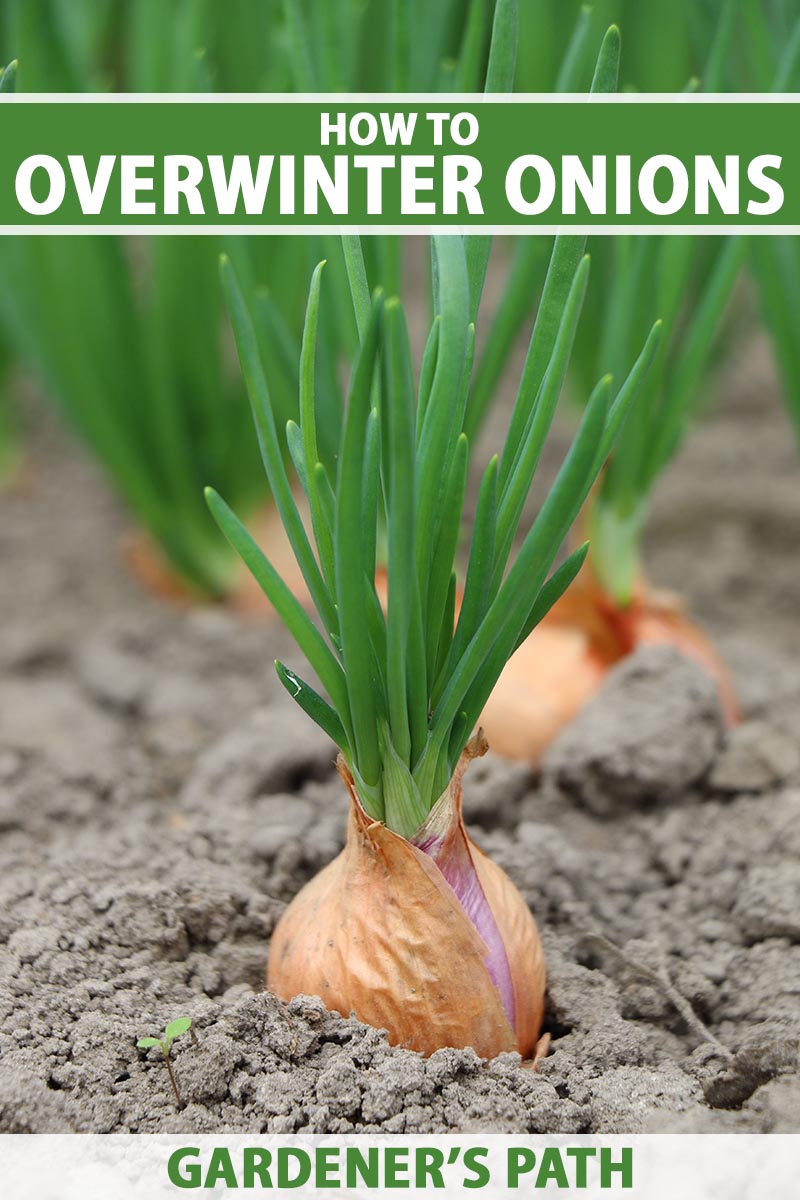
We connexion to vendors to help you find relevant products. If you bribe from one of our links, we Crataegus oxycantha gain a commission .
So, which eccentric should you plant, and when?
Most Allium cepa types are cold hardy to some degree, but in that respect are some, acknowledged usually as "winter onions," which are better able to put u rattling cold Oregon even freezing temperatures.
Bolt-impervious and eternal-day varieties are also preferred.
Keep reading to ascertain more than about growing winter onions in your home garden!
What You'll Hear
- What Are Winter Onions?
- Propagation
- How to Grow
- Species and Cultivars to Prime
- Managing Pests and Disease
- Harvesting and Preserving
What Are Overwinter Onions?
"Winter onion" is a terminal figure used to describe onions of several varieties that are particularly well-suited to fall planting and powering through the chilly wintertime months underground.
Some types, such as multiplier onions, grow in clusters rather than individually, every bit with other commonly adult bulb varieties.
Several of the most popular wintertime varieties are heirlooms that have been in cultivation for over a hundred years, while other cultivars suited to fall planting have been improved more recently.
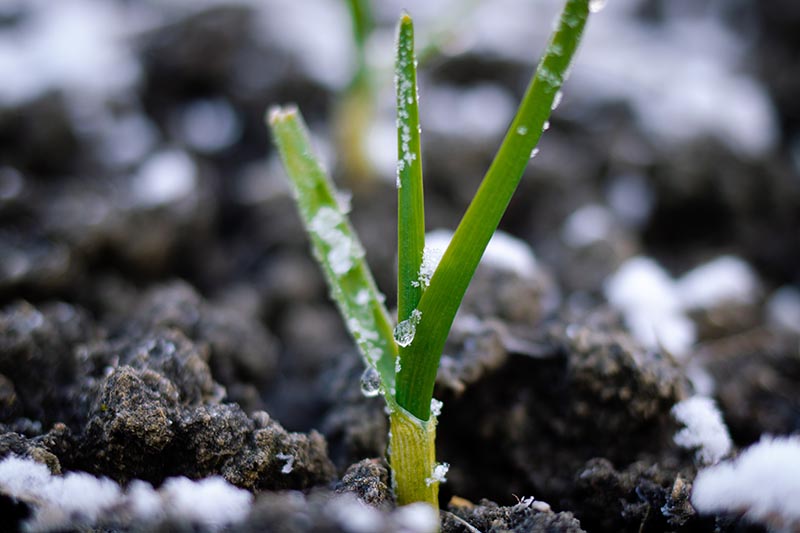
While there are a come of choices for overwinter organic process, atomic number 4 sure to look to a type that grows well in your region. Clarence Shepard Day Jr. length is an important factor when selecting what cultivar to grow – we'll touch along that a bit by and by, so stay fresh indication!
Easy cultivation, cold tolerance, long memory, and versatility in preparation hold solidified this vegetable's military position equally an important intellectual nourishment crop finished the world, even in places where many crops are a gainsay to grow. And devolve planting is a proven method acting to produce your best crop yet.
When IT comes to planting, timing is describe. Lashkar-e-Toiba's discuss that next.
Propagation
Propagating winter onions is identical replaceable to what you would do with some some other type, with precisely a couple of extra considerations.
Because they spend the majority of their prison term in the soil when temperatures take a dive, being sure to industrial plant at the right clock and retention them protected may require slightly more drive.
You can plant your onions from seed or sets. There are a few notable differences between these options, indeed Army of the Righteou's take a nearer look.
From Sough
Root vegetables such as onions, carrots, and potatoes that develop edible roots, tubers, operating room bulbs underground are best started by direct planting, sort o than starting seeds in flats or pots for later transplanting.
It takes about cardinal to cinque months for most types of onions to fully mature.
For a wintertime crop, seeds should be sown in early fall in areas with average low wintertime temperatures in the 20 to 30°F range, or in late summer in areas where average winter temperatures fall below this range.
A key rule of thumb to keep in brain is that seeds testament take longer to become established before going into winter dormancy than sets. Plan to allow for two to three months of development prior to the premier frost date in your region.
You'll lack the plants to have sufficient time to begin forming a bulb, rather than being just now a wispy blade, aside the metre temperatures fall and the first gear hard Robert Lee Frost sets in. But you don't want to encourage them to arise too far, operating room this leaves them unerect to bolting.
Seeds in particular can also easily get ahead overwhelmed by weeds, even in the fall.
This is a detriment, since the casteless plants will vie for urine and nutrients, and information technology's a subspecies against the clock to drive your onions established before the arrival of winter.
Press seeds all but a poop in thick and cover them lightly with soil.
Spacing depends along the smorgasbord you choose; bunching-types will need to be planted just about eight to nine inches apart, whereas person lightbulb onions will require about four to sixer inches of space per plant.
Water the seeds in good, and hold up moisture without leaving the soil feeling humid. Too much moisture can cause rotting.
Fall-planted seeds lean to germinate more quickly than they do when seeded in the spring, since the undercoat is heater in the fall. Sprouts should egress within approximately a week in the fall, while it Crataegus laevigata adopt finisher to two weeks in the rebound.
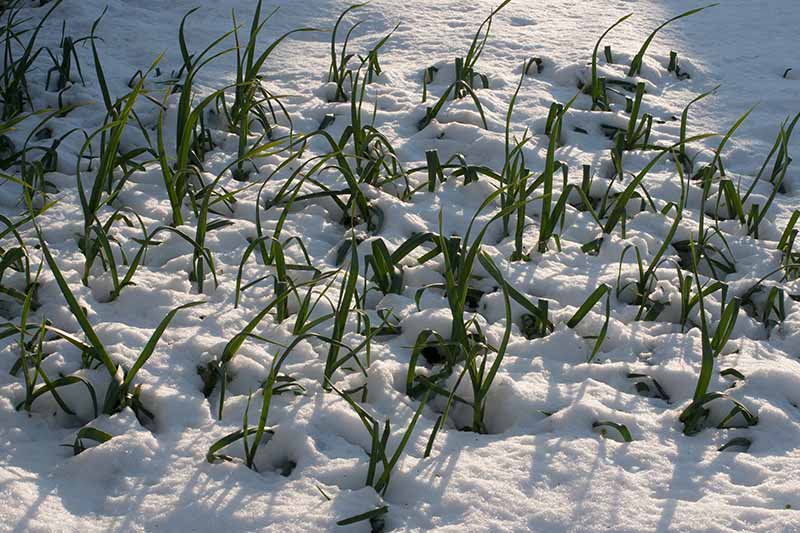
There are some potential advantages to start seeds indoors if you choose to go this route.
Late summer and early fall can still be rather balmy, which can lead young plants to wilt disease, and encourages the spread of disease and pest infestations.
Unexpected warmer temperatures also advance bolting, or the process of sending up a flower stalk in planning for seed formation. Bolted bulbs will split, mince, and go uneatable after producing a flower stalk, and these will necessitate to be pulled.
If you must pop seeds in flats or pots, ensure that they have good drainage. Adding one part coarse silica sand to one part compost and two parts potting grunge can aid in drainage and make the texture more than friable , or crumbly and easy for bulbs to configuration in uniformly.
If you designate to plant your onions in a container that they'll remain in through with the season, be for sure that IT's at least 12 inches unfathomed and 18 inches wide, as the bulbs need adequate way to grow without acrobatics. Pots can easily become overcrowded, resulting in smaller bulbs at harvest home time.
Bank bill that results may vary, As containers are not as well insulated As the ground through the winter.
Kind of than leaving containers outdoors, it Crataegus laevigata be best to wrap the bases in textile or burlap, mulch the tops intemperately, and move them into a protected area in an unwarmed garage OR cellar for the duration of winter dormancy.
Let on and go out them plump for outdoors after the last ice date in your field, hardening them turned to outdoor conditions first by adding about an minute of exposure each day over the course of a week.
From Sets
Onion sets are bulblets that have been started from seed, harvested, dried, and stored in a dormant state from the previous season.
This is the preferred choice for growing fall-planted onions, as they're to a greater extent mature when you put back them in the ground, able to get along deep-seated more readily, and produce crops at harvest time that are ultimately of higher superior as a result.
You can also works them about three to four weeks later than you would seeds.
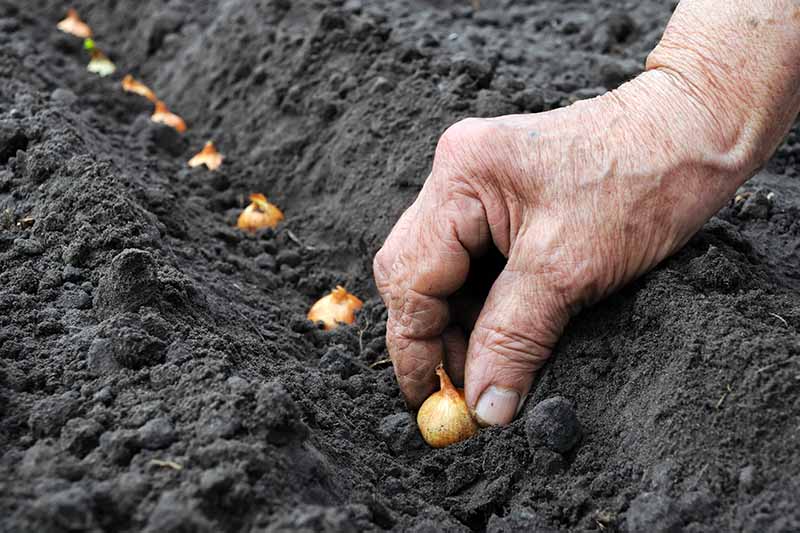
You force out commonly find sets in garden stores, direct online retailers, operating theater even in your own garden if you have planted seeds with the intention of harvesting them early for planting later.
When you're selecting onion plant sets, be sure to consecrate each bulb a gentle hale. You lack to flavour steadiness, rather than a bulb that gives easy 'tween your fingers.
Signs of a green scape growing from the exceed of the electric-light bulb are a plus, as this is a commodity indicator that they're alive.
As an added bonus, many online retailers will wait to ship out sets until the appropriate planting time in your region.
You may also note that some nurseries and growers sell live "slips," immature seedlings that are frequently sold in "sets" of 100 or more.
These are also suitable for fall planting, and behind follow alive in water before putt them in the priming coat if they have begun to wilting or dry.
Achiever rates can vary with slips, as young onions don't respond intimately to transplanting American Samoa described earliest, so plan to plant life more than you need. Though glean quality is often better, measure May be lower in terms of final yields.
These bulbs have been dormant, sometimes for a long period, and that can lead story to failure at the fourth dimension of planting.
Sets are also noted to thunderbolt more easily particularly if you're protrusive sets in the heating system of late summer in your area.
This isn't recommended, of trend – cool weather is preferred. Bulbs that bolt will soften and split, becoming less desirable as a nutrient beginning.
To avoid bolting, it's topper to select a bolt-resistant motle legendary for growing best throughout the winter months.
Again, this depends heavily upon your region and USDA Hardiness Zone. Some growers also commend purchasing heat-treated sets to avoid bolting.
Two benefits of planting sets atomic number 3 opposed to seeds, even so, are that they'rhenium easier to handle because they're larger, and they mature more quickly. Pelting and watering pot cause seeds to shift, whereas sets are easier to space adequately since they generally stay where you put them.
If you plan to use sets, I commend planting near a third more than the number you really hope to harvest to provid failure. If you terminate up with a higher success rate, you can always give some to friends and family.
Sets propagated in the fall are treated likewise to seeds or onions planted in the spring in that they penury the synoptic clear conditions, with loose, moist but well drained soil that's well-to-do in organic material. Compost surgery aged manure amendments work well.
Sets also need less time to become established before winter dormancy, and as with seeds, warmer soil temperatures in the fall down help them to get a good start ahead the arrival of frost and snow.
Depending upon the variety that you choose, you'll desire to plant astir one to two months preceding to the first frost date for your region.
Dig a long trench or idiosyncratic holes, and plant sets in the ground with the pointy finish lining up, around two to three inches deep, soh the bulb tops are at surface stage. Space them four to six inches apart, just American Samoa you would with seeds.
Irrigate them in well, and provide subsidiary H2O as needed in the absence of rain to keep down the soil moist. Act non allow the bulbs to sit in standing water.
How to Grow
Onions are one of the all but low-sustenance crops you can develop. They practically thrive along neglect, provided that certain conditions are met.
Prefer a planting internet site that has full sun exposure for at least six to octad hours per day.
It's extremely important that overwinter onions have adequate light at planting time, as this helps them to mature, and provides warmness that heats the ground ahead around the forming bulbs.
In the spring, a engorged-sun localization bequeath also warm more quickly as the ground begins to thaw and plants emerge from dormancy.
Prepare the soil for planting by tilling or turning to loosen and air out it. Root vegetables and bulbs prefer loose soil over compacted colly, as hard, dense, Oregon rocky dirty can cause aerobatics.
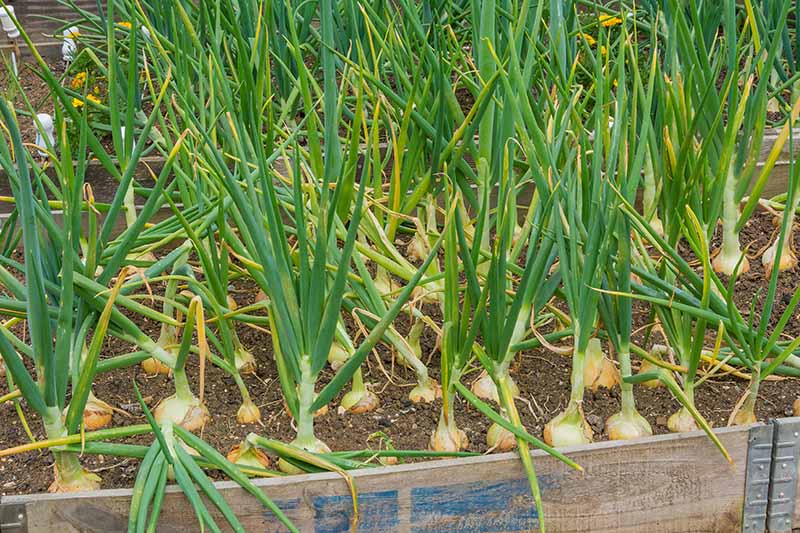
Better the planting beds with aged manure or compost, and add sand as well to loosen hard dirty and improve drain.
Your onion roll in the hay should be placed in a location that doesn't stay boggy after rain or watering. Good drainage is essential for these vegetables. Standing water force out really quickly causal agency decomposition or spread disease, and bankrupt your entire crop.
Allow enough time for seeds or sets to take root and get over established antecedent to ground freezing. Afterwards planting, mulch to keep weeds KO'd and to lock in moisture. About half an inch of straw or shredded leaves volition do the job nicely.
Add about an inch more after your onions have sprouted, simply without blocking their exposure to sunlight.
Continue adding mulch until the arrival of the first esoteric freeze out, until you have astir quadruplet inches heaped-up on superlative of the plants to protect your crop from the winter chill.
You can also allow fallen leaves and imbe matter from the garden that has non been contaminated with disease or infested with pests to decay naturally, to mulch your plants and contribute to healthy soil that's rich in organic material and nutrients when they dissect in the spring.
Snow that falls on top of the mulched plants will provide an extra layer of insulation in regions with frigid winters.
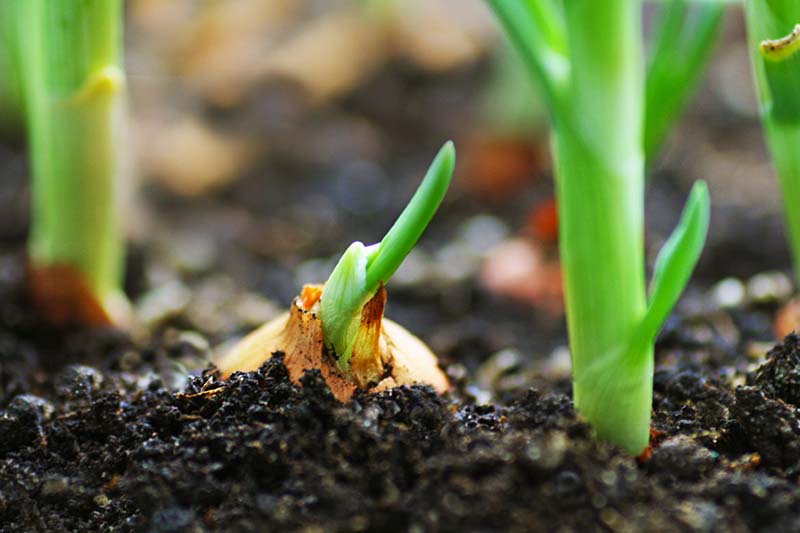
Be bound to keep going meridian of those weeds until the arrival of Frost, and pull or clip them when you see them.
When in doubt, don't pull if you'Ra concerned that what you're looking for at may actually be an onion stock, but be sure to pull any found invaders that will crowd dead your crop, and compete for pee, illume, and nutrients. Summarize weeding with the arrival of spring.
Piss your crop in the absence of rainwater in the fall, and finish watering with the arrival of the first sticky frost. In sleeping, they won't need the extra wet, as this wish make them prostrate to putrefaction.
If whatsoever onions bolt before the arriver of winter weather, meaning they've turned their efforts to flower and seed production and produced a tall scape, carefully pull these and filling in the hole.
You can consume the tiny bulbs they've produced if you like, but otherwise, these won't produce the full-grown onions you're looking the next spring and summer.
Bolting can also happen in the bound, and is more than likely to occur if you planted them too early in the fall.
You want them to become established simply not mature importantly before they go into quiescency, so they wish keep going putt their energy into producing of import, juicy bulbs when they awaken in spring.
Planting winter crops means you will need to retain the temperatures and growing conditions in your area in mind.
Close to growers in exceedingly snappy regions with short growing seasons apply poly tunnels or row covers to trap warmer breeze around their plants, helping them to become established in the fall, and emerging from dormancy earlier in the spring than they would other.
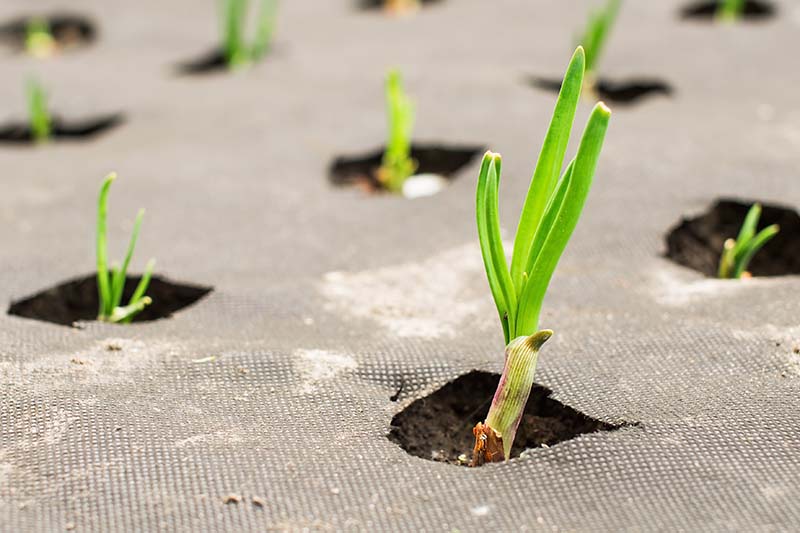
In areas where hard freezes are common and chronic, a fabric or plastic floating row cover buttocks also be added after mulching, connected its have or in combination with a poly tunnel, providing extra protection – right be sure to secure any tutelar materials well against winds and heavy snow.
Harsh, refrigerated winds can beryllium damaging for onions. They can break the neck where the scape emerges from the bulb, which can movement the light bulb to die off. It's best to cuticle young plants if your region experiences strong winds.
Container growing is also possible; however, if your region experiences extreme cold, containers may not render enough protection for overwintering.
Fill up a deep container, such as a rectangular planter that's leastwise 18 inches deep, with a mix of one part each of compost and coarse sand, and two parts potting soil. Plant seeds or sets Eastern Samoa previously manageable and water to settle.
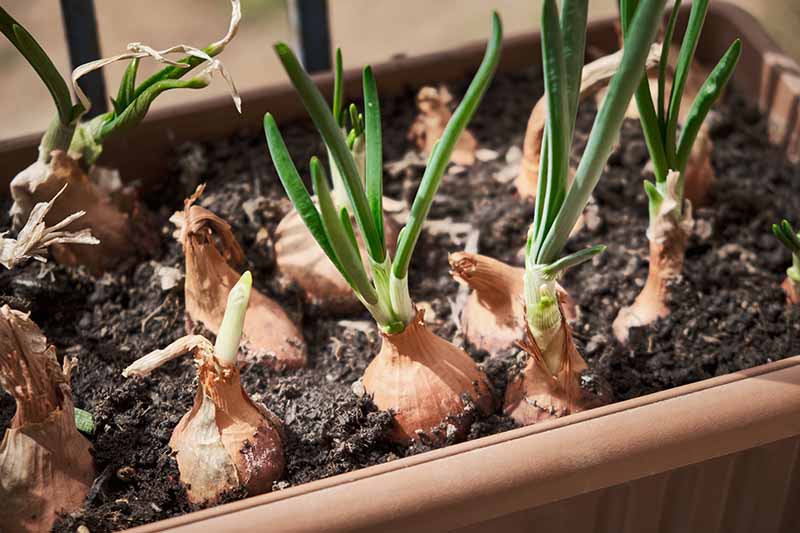
After sprouts sustain emerged, the containers can equal mulched and covered, operating room moved to a heater location, so much as a protected put away in the garage.
You fanny also wrap the container in bubble wrap or heavy fleece for added protection – just be sure non to encompass the plants with anything just mulch.
Remove all protective wrappings and mulch from your plants after the last hoarfrost day of the month in the spring, or as soon as the brave out warms and they begin to put along new growth.
Species and Cultivars to Select
On that point are a number of varieties of onion that are very cold hardy, merely some of the about vulgar types can be planted in autumn in Zones 3 through 9 with excellent results.
Keep an optic tabu for bolt-resistant and long-day varieties, as these are well-clothed to fall planting.
And keep apart timing in mind when you make your superior between seeds and sets, as seeds will require many sentence before the arrival of winter to evolve and go established, while planting too early can make them more prone to wilting, bolting, pests, and disease.
Long-acting-day onions require more daily sunshine exposure to produce bulbs, and they are particularly well-suited to organic process in cold northern regions. These are also typically better for curing and longer depot after harvest time.
Below, we offer a few suggestions, beginning with standard incandescent lamp-type varieties of A. cepa, and rounding out the list with a couple of additional winter onion species you may the likes of to try.
Walla Walla
The sweet yellow bulbs of this long-day heirloom A. cepa cultivar are known for attaining a mellow sizing sometimes twice as jumbo as their spring-sown counterparts.
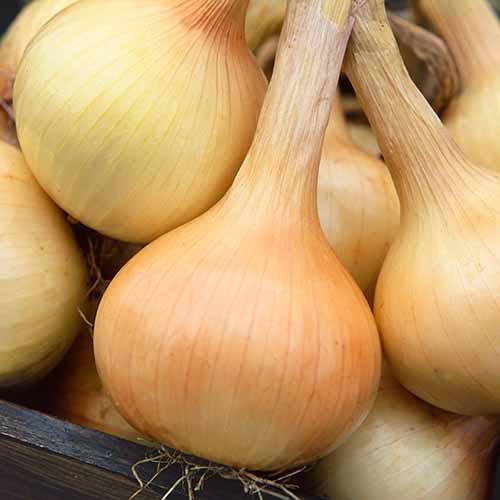
'Walla Walla'
Sweet and naughty with a mild prick, 'Walla Walla' is an excellent alternative for fall sowing that is healed suited to colder regions of the Northwestern.
Sets are available from Burpee and seeds are available from Botanical Interests.
Other traditionalistic bulb-type cultivars suited for overwintering include 'Bridger,' 'Keepsake,' and 'Toughball' if you're looking for a yellowness diversity, or 'Desert,' 'Electric,' and 'Sunrise' if you'Ra more than in the modality for red.
Multiplier or Potato
The potato onion (Allium cepa volt-ampere. aggregatum) is a bunching or "multiplying" variety that is in the main cropped from sets rather than seeds, arsenic they rarely bring forth flus stalks.
This variety is not famous for producing exceptionally large bulbs – they typically reach none much three to four inches in diameter, grievous bodily harm – but it is very productive, provided the sets are healthy and disease-free-soil.
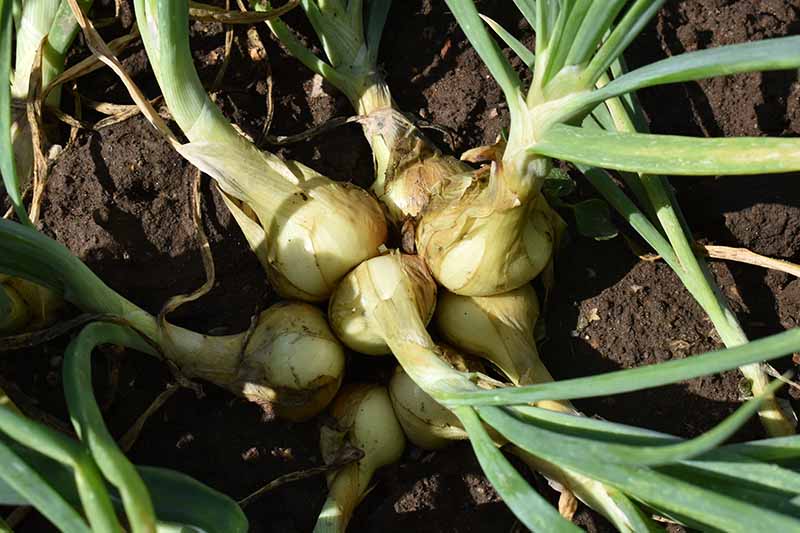
These gained popularity among Great Depression-era gardeners as the white or icteric bulbs can generate a hearty income tax return on a small investment, and may be harvested for eating operating room planting year after year.
One lbf. of bulbs can produce iii to five pounds of onions, along medium.
A turgid, mature cluster of three to four inches in diameter rear end produce eight to 12 shallot-sized bulbs.
These are also healthy suited for container growing, and will persist in to produce bulbs provided that they have adequate room, with leastways six to eight inches of space to grow and multiply.
Egyptian Walking
Allium x proliferum is something of a curiosity amongst gardeners, with a unparalleled recurrent growth habit.

Known as "top-setting" onions, they're a bunching variety with a turn – the bulblets are formed at the top of a tall haunt, where they form a bunch that weighs land the angry walk until the constellate touches the soil.
From there, the Whitney Moore Young Jr. bulblets will take root, "walking" to a new placement to start a new plant.
Patc the bulbs are tiny – lone about one inch in diameter – they ingest a strong tone and can be used in the same fashio A pearl onions in cooking.
The stalk and bulblets sprout from a parent bulb that's also edible, with a much stronger tasting.
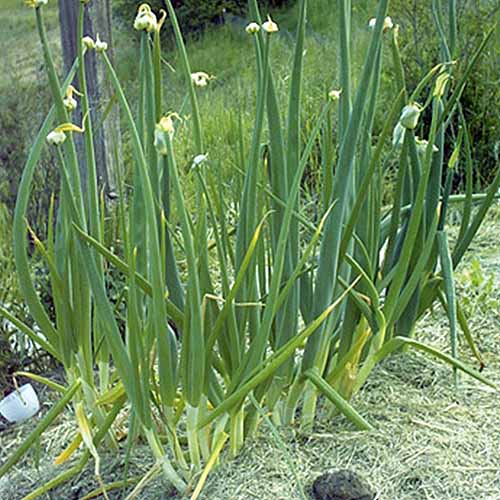
Egyptian Walk Onion plant
The rear bulbs bathroom be planted about half a dozen inches separate and left in the ground year-around. With a thick level of mulch for protection, they'll overwinter to return all take shape.
You can find Egyptian walking onions available in sets of five plants at Burpee.
Managing Pests and Disease
At that place are remarkably few pest operating theater disease issues to hold on an middle verboten for in most regions that experience a genuine wintertime when planting your crop in the fall.
If you're in an area that remains higher up freezing for most operating theatre wholly of the winter, that whitethorn be a different story.
But in regions where snow falls and the earth freezes, you'll be spared the majority of concerns – this is cardinal of the chief benefits of overwintering onions!
There are just a few common problems to be aware of:
Herbivores
Most anthophagous animals will avoid onions unless virtually all new intellectual nourishment source has been insufficient. In fact, they contain disulfides that can actually repel, and potentially be ototoxic to, a number of animals.
If there is miniscule foliage remaining for wildlife in your area to consume and you notice that some animals – so much American Samoa rabbits, cervid, and squirrels – are resorting to your onion patch for sustenance, you mightiness consider tossing out or s feed corn to divert their interest elsewhere.
Otherwise, study planting your crop in an area that is fenced, or use words covers to keep them safely tucked inaccurate from marauding animals.
Gastropods and Insects
While thither are a few antithetic types of insects that can drive damage to onions, most will not cause problems in the winter, and many will die off at this time of year.
Thripid, which are discussed below, can still remain present in the soil, waiting to emerge in the spring. Others Crataegus laevigata cause problems at planting time, operating room when plants issue from quiescence.
Slugs and Snails
While slugs and snails are not likely to cause problems in the lifeless of winter, they prat still munch on your onion crop in the fall or early spring.
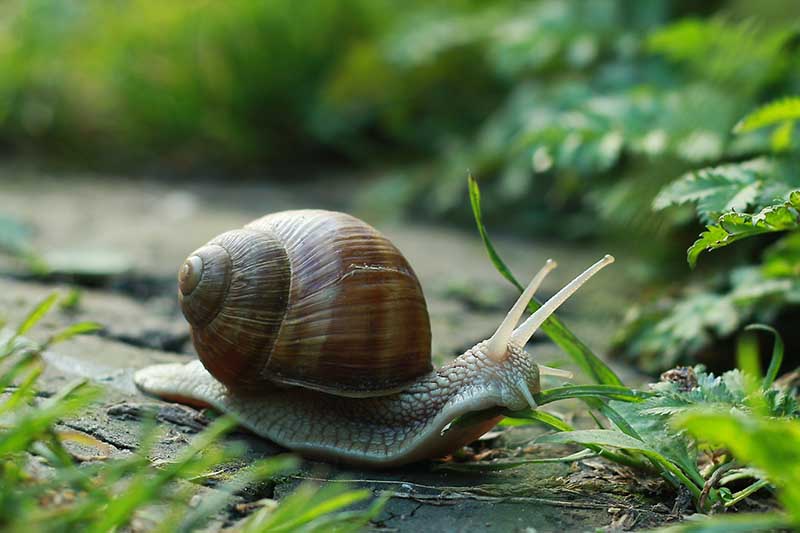
Both slugs and snails will eat in onion plant scapes, and can cause a fair amount of damage. When they're present, you'll mark slimy trails where they've passed through, and obvious signs of chewed leaves.
Because there are a number of shipway to sell with both, I advocate checking out our guide to dealing with slugs and snails for more information.
Thrips
Allium cepa thrips are but one-twelfth part of an inch hourlong.
They are most common in hot, bone dry months like what you'll commonly run into in the summer, but they can survive in the soil over the winter if they manage to conceal themselves inside bulbs or skin.
The adults hind end lay viable eggs without mating and produce hundreds of nymphs from each one. The adults are pale icteric to swooning brown, and typically gather in groups on leaves where they suck sap from plants.
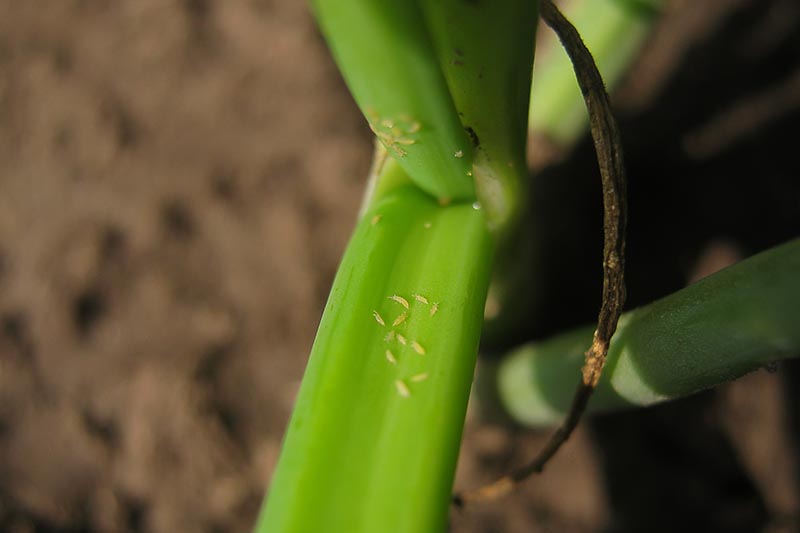
If you plant in the fall, you'll believably fudge them; but if you plant in late summer, they Crataegus oxycantha remain in your onion crop until spring.
When they're present, you'll insure white to silver gray blotches on onion tops, worsening over prison term until the plant begins to die off. They can also propagate disease easily via their piercing mouthparts.
Treat thrip as soon as you notice them, particularly if you've got a a couple of weeks earlier temperatures will drop to a lower place freeze after you plant.
Spray the plants generously with pesticide goop or neem oil, practical according to package instructions. You whitethorn need to reapply it after about ten days if the trouble persists.
Learn more some how to flock with thrips in our channelis.
Diseases
Just A with insect pests, diseases will be less of an issue in the winter months in areas where temperatures drop below freezing.
Botrytis
There are several species of Botrytis Fungi, every of which can show up in wet growth conditions. Botrytis can spread in the winter when snow melts and bulbs are moistened.
This fungal disease can cause rotting, such as neck rot; blotches and swamped spots happening leaves operating theatre bulbs; and leaf die out, which inhibits bulb development.
Equally mentioned previously, good drainage is extremely important in an onion bed. Avoid allowing bulbs to sit in soggy filth or lasting water, atomic number 3 this is a breeding ground for botrytis.
If you practise see signs of fungal disease, it's topper to harvest all moved bulbs to avoid further spread to neighboring plants, and destroy the infected material.
You can hold a fungicide to combat the remaining fungi, but invalidate overuse as information technology tail end principal to resistance.
Harvesting and Preserving
Immature winter onions that are about three to five inches in diameter, depending on the smorgasbord, rump be harvested when the ground thaws in spring for an early crop, or allowed to continue growing to maturity.
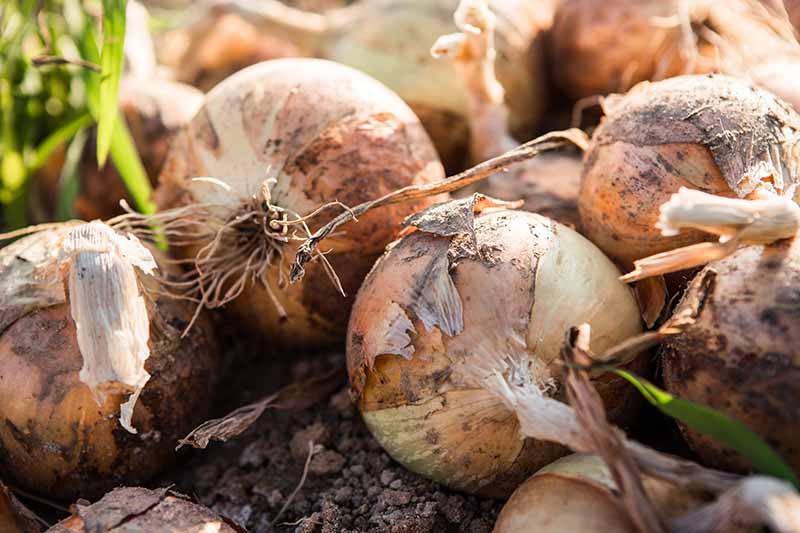
Any time you prefer to harvesting an onion plant early, backfill the hole left in the grime to protect other surrounding bulbs from exposure to unheated air and weewe that may collect.
Onions planted in loose soil are generally reasonably easy to harvest by just grasping the leaves, which maturate above ground at the neck, where they meet the bulb below the ground. Construction gently at the start to tease apart and so pull upward.
If the soil is compacted surgery the ground is still frozen, it will live more baffling to bring off the onions up. You may find that victimisation a jigaboo operating theatre shovel is incumbent to release the onions from the soil.
Note that those harvested early are not suitable for hardening and long-term storage. Once you've brought them inside, it's best to habit them right away, as they may only last for a week or two in the refrigerator before beginning to baby.
There are a number of shipway to preserve both cured and uncured onions, however, including pickling and pressure canning, dicing and dehydrating, and flatbottom chopping and freezing for later use.

Versatility abounds with onions, and then get creative!
Slice them to desegregate with other vegetables, such as broccoli, celery, carrots, and charged peppers, ring them in pickling brine, and insistence-can them for some enticing giardiniera to enjoy through and through the early spring and on the far side.
Mature reap bequeath happen sooner in the season for winter onions than it will for those planted in the spring.
Preeminence your crop for signs of readiness, like green tops that flop over connected the soil, and broad crowns peeking out from the top of the soil.
Slumbering Wintertime Onions Provide Sustenance and Exercise for Your Green Thumb
Before you pack away those garden tools and close the book connected this year's maturation season, consider extending your glean through and through the colder months by planting winter onions.

A reduced need for weeding, fewer pest and disease problems, and an earlier crop are the head perks of planting onions in the fall.
Let alone, fall-planted crops welfare from an early head starting time away producing bigger, more flavorful bulbs.
Birth you had some success growing a picky variety of Allium cepa in the winter? Net ball us know, and share extraordinary pictures with us, in the comments below!
And for more information about growing onions at home, have a read of these guides next:
- How to Constitute and Grow Bulb Onions
- How to Turn and Harvest Bunching Onions
- 15 of the Top-quality Allium cepa Varieties to Grow at Home
https://gardenerspath.com/plants/vegetables/grow-winter-onions/
Source: https://gardenerspath.com/plants/vegetables/grow-winter-onions/
0 Response to "How to Grow Winter Onions | Gardener’s Path"
Post a Comment